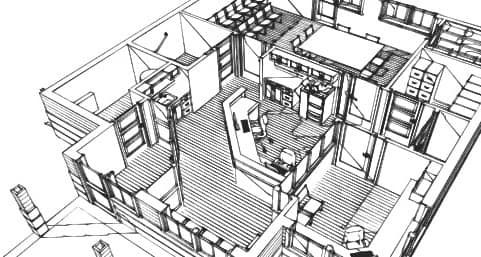Nurse, doctor, mechanic, carpenter, lawyer, prostitute……..architect. These occupational titles are well-seated in the vocabulary of most. They are descriptive and, though there’s variance in the specific duties and specialties these professionals perform, it’s generally understood what they mean. Some are even evocative, due in most part to romantic portrayals in popular media. Say “lawyer,” and some might picture a passionate and moving discourse delivered by a high-powered individual with magazine cover good looks. Say “architect,” and some might picture the artistic eccentric creating designs the likes of which no one’s ever seen, perhaps on a napkin. Usually they’re fashionably dressed and, of course, very wealthy.
Say “Licensed Technologist OAA” and you’re usually met with blank stares and slow blinking, perhaps even the sound of crickets, real or imagined. Absent a big-budget Hollywood movie starring a struggling, but ultimately triumphant licensed technologist, I find it’s necessary to resort to an expanded description for what it is I am and what it is I do and why it’s valuable.
As a self-employed licensed technologist, how do I describe myself?
I start by explaining that I’m an architectural technologist (a protected title, by the way). Blinking rate increases a little, possibly accompanied by a slight tilt of the head.
“I used to work for an architect.” Â I say.
A slight head nod, maybe even an “oh.”
Sigh “I draw blueprints for buildings.” I omit the explanation that blueprints aren’t made anymore and that the ammonia is toxic to our environment.
“Oh, I see!”
This painful (but thankfully short) conversation is almost always accompanied by this follow-up exchange:
“So, uhh, what’s the difference between an architect and an architectural technologist?”
After trying many different approaches, the following is what I usually resort to:
“It’s like the difference between a doctor and a nurse.”
“Oh! So you do all the work!”
Answering with a chuckle and a “yeah, sure” usually seems to please the inquisitor.
Thankfully, the occupational description of architectural technologist is well-understood within the AEC industry. But when speaking to laypersons, I’ve found the nurse-doctor comparison to be fairly effective, perhaps not completely relevant, but effective nonetheless.
In Ontario at least, our particular occupation is different in that the best title to describe what we do is actually a title protected under the Association of Architectural Technologists of Ontario Act, 1996 (AATO Act). Non-licensed technologists are not permitted to use the title “architectural technologist” as an occupational description. However, the AATO Act provides exceptions for licensed OAA members:
It is not an offense under subsection (2) for the following persons to use the designations “architectural technician” or “architecte-technicien” or “architectural technologist” or “architecte-technologue”:
 1. A holder of a license, certificate of practice or temporary license issued under the Architects Act.
This means that those who have become licensed as technologists by the OAA may indeed call themselves “architectural technologists.” Architects, incidentally, may do so as well.
Through conversations with students and other technologists in the field, it’s become clear that the right to use this designation is important. We need to raise the profile of our profession and its role in the creation of architecture. It can be a challenge because the designation of architect is better understood and you must be licensed to practice architecture yet you don’t have to be licensed to be a technologist. Because of this, and for those that are entitled, I encourage you to use it as often as you can.
The architect, the architectural technologist, the drafts person. All these occupations play a crucial role in the development of a project from initial conception through to project completion. These roles are always required. Depending on the size of the firm, it’s not uncommon for one person to fulfill all three. For sole practitioners and other small firms, it’s not uncommon for the owner (whether architect or technologist) to have separate billing rates for each person, even though each person is one and the same. This serves to illustrate the importance of the different types of skill sets required to successfully create a piece of architecture.
Now if only Hollywood would come calling. I can’t wait for the passionately delivered diatribe “no!! If only they’d used LVL studs for that tall wall!!”
Are you interested in being a Guest Blogger on Shoegnome? Do you have some thoughts about the practice of architecture in the 21st Century? Send me (Jared) an e-mail. And in the meantime, follow Shoegnome on Facebook, Twitter, and RSS feed. And now you can join the LinkedIN group too!

1 thought on “Guest Blogger Jeremiah Gammond: What’s in a Name?”
I tend to avoid using the term “Architect” only because the profession and what it does has been so demeaned and defined by the media, especially the ignorant TV talking heads who host shows like Grand Designs or This Old House. In some cases, the negative reputation is well deserved especially when buildings fail and it’s clear that the designer had no knowledge of building science or engineering. Don’t get me started on the some serious needs to beef up educational requirements for graduating from architecture schools these days.
I gravitate toward referring to what I do and what my firm does as “curators of human habitat” being fed up with most people thinking of architects as simply extraneous and expensive drawing services…..